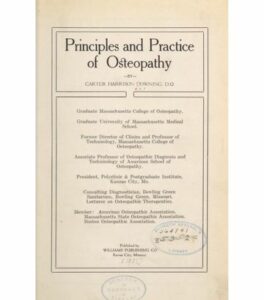Principles and Practice of Osteopathy by Carter Harrison Downing
A volume specifically centered on some aspects of the osteopathic techniques, those most favorable for the patient, less onerous for the practitioner and less time-consuming.
 Publisher: Williams Publishing Co., Kansas City, Missouri
Publisher: Williams Publishing Co., Kansas City, Missouri
Year of publication: 1923
Number of pages: 442 (but from page 406 the pages are blank to allow the reader to take notes).
The author, who was a lecturer at the Massachusetts College of Osteopathy and at the ASO, declares to have composed this work by describing the new developments of osteopathy limited to the most important ones, selected on the basis of his own experiences, observations and research.
The volume is divided into twelve chapters, the first of which is dedicated to the osteopathic principles, presented with great clarity.
Besides the concepts of structure and function other themes are addressed, for example: the modification of the cell during sickness, the vasomotor system, arterial tension, sympathetic system, neurovegetative system, nervous mechanism, reflex arc, abdominal disorders of sympathetic origin, vagotonia, sympathicotonia, inhibition and stimulation, germ theory.
The second chapter defines the osteopathic vertebral lesion and the third one the spine. The remaining chapters deal with specific dislocations and subluxations and provide the description of lesion, diagnosis, suggested treatments and the author’s reflections.
Strengths:
- The language is clear, the principles are presented in a logical and concise manner;
- A detailed index at the beginning of the volume for easy reference;
- There are several drawing and explicative photographs.
- The exposition of the osteopathic principles is very interesting from a historical point of view as it provides a photograph of the theoretical foundation of the discipline in the twenties of the twentieth century.
- As J. H. Styles, DO, author of the introduction to the volume, states that the book is permeated by the spirit of osteopathy.
Weaknesses: there is no analytical index.
The enthusiastic foreword of Dr FP. Millard praises the brilliant competence of Dr Downing in understanding human nature and his ability to perform joint corrections in a very swift way, obtaining excellent results.
- Chapter 1 – Osteopathy, the science
- Chapter 2 – The osteopathic spinal lesion
- Chapter 3 – The vertebral column
- Chapter 4 – Occipital-atlantal subluxations
- Chapter 5 – Atlanto-axial subluxations
- Chapter 6 – Subluxations of the cervical vertebrae from the second to the seventh inclusive
- Chapter 7 – Subluxations of the thoracic vertebrae
- Chapter 8 – Subluxations of the lumbar vertebrae
- Chapter 9 – Subluxations sacro-iliac articulations
- Chapter 10 – Costa subluxations
- Chapter 11 – Foot subluxations
- Chapter 12 – Luxations, partial and complete

Are you an osteopath?
Register and enjoy the membership benefits. Create your public profile and publish your studies. It's free!
Register now
School or training institution?
Register and enjoy the membership benefits. Create your public profile and publish your studies. It's free!
Register now
Do you want to become an osteopath? Are you a student?
Register and enjoy the membership benefits. Create your public profile and publish your studies. It's free!
Register nowHistorical osteopathy books
Osteopathy Research and Practice by Andrew Taylor Still
The fourth book of A.T. Still, written at the age of 82 years, enunciates the principles and the practical maneuvers of osteopathy in reference to the single pathologies, classified by body regions.
ReadHistory of Osteopathy and Twentieth-Century Medical Practice by Emmons Rutledge Booth
A milestone in the history of osteopathy. Emmons Rutledge Booth, who enrolled at the ASO in Kirksville in 1898 and graduated in 1900, met A.T. Still personally.
ReadPhilosophy of Osteopathy by Andrew Taylor Still
The second book published by A.T. Still, it collects the basic principles of osteopathy, written over several years and then gathered in one volume. Despite the insistence of his friends, Still was not sure that the time was ripe to divulge his early science.
ReadAutobiography of Andrew Taylor Still with a History of the Discovery and Development of the Science of Osteopathy by A. T. Still
A fundamental text to begin to know the founder of osteopathy and to understand the cultural context and the historical events during which his life unfolded.
ReadPrimitive Physick: or, an Easy and Natural Method of Curing most Diseases by John Wesley
A fundamental text for the Methodists, which Still’s father surely knew and probably owned - in addition to remedies, the book contains a preface that dispenses advice for a healthy life.
ReadThe Old Doctor by Leon Elwin Page
A small volume dedicated to the story of Andrew Taylor Still, and to the birth and development of the idea of osteopathy.
ReadThe Cure of Disease by Osteopathy, Hydropathy and Hygiene A Book for the People by Ferdinand L. Matthay
A small volume addressed to the general public, dispensing health advice and illustrating some osteopathic techniques.
ReadOsteopathy; the New Science by William Livingston Harlan
The volume collects and comments a series of relevant articles on the new science of osteopathy, highlighting legal, historical and theoretical aspects.
ReadA Manual of Osteopathy – with the Application of Physical Culture, Baths and Diet by Eduard W Goetz
Very schematic volume, with the aim of spreading the osteopathic application techniques to everybody, even to those lacking any sort of health training.
Read







